Unit 6: Managing Talent Strategies at Next plc - Project Report
VerifiedAdded on 2023/01/05
|28
|6455
|2
Project
AI Summary
This project report examines talent management strategies, focusing on employee retention and attraction within Next plc. The report begins with an introduction to talent management and its importance, particularly addressing the issue of high employee turnover. It then outlines the project's aim, objectives, and research questions, followed by a literature review exploring the significance of employee retention and attraction, and potential talent management strategies. The main body of the report details the design of a project management plan, including deliverables, timeframes using Work Breakdown Structure and Gantt charts, quality control, communication channels, risk assessment, and resources. The research methodology, involving primary and secondary research, is also discussed. The report presents the results and data analysis, followed by recommendations. It reflects on the project's value and concludes with references and appendices, including a performance review. The project aims to evaluate and recommend talent management strategies for Next plc to improve employee retention and attraction.
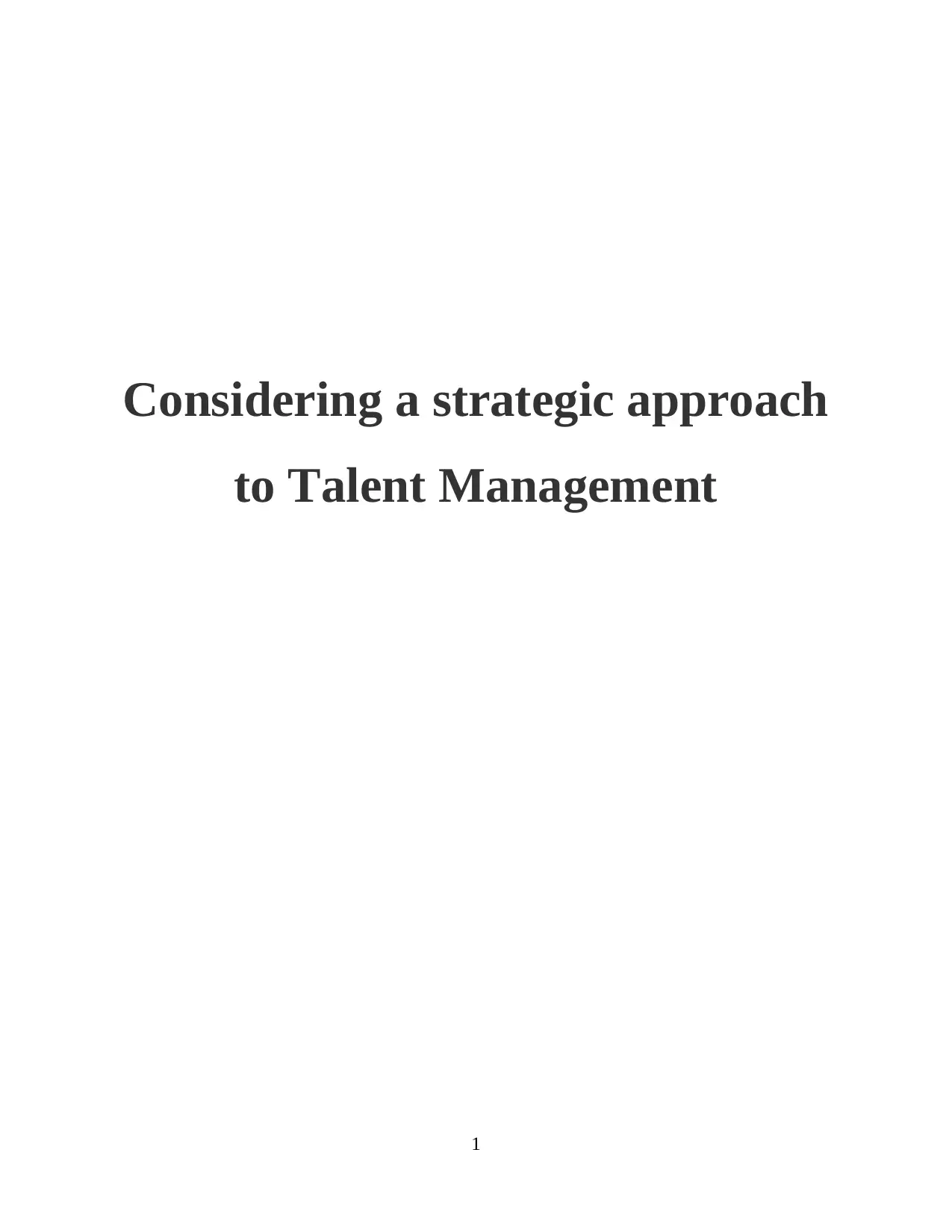
Considering a strategic approach
to Talent Management
1
to Talent Management
1
Paraphrase This Document
Need a fresh take? Get an instant paraphrase of this document with our AI Paraphraser
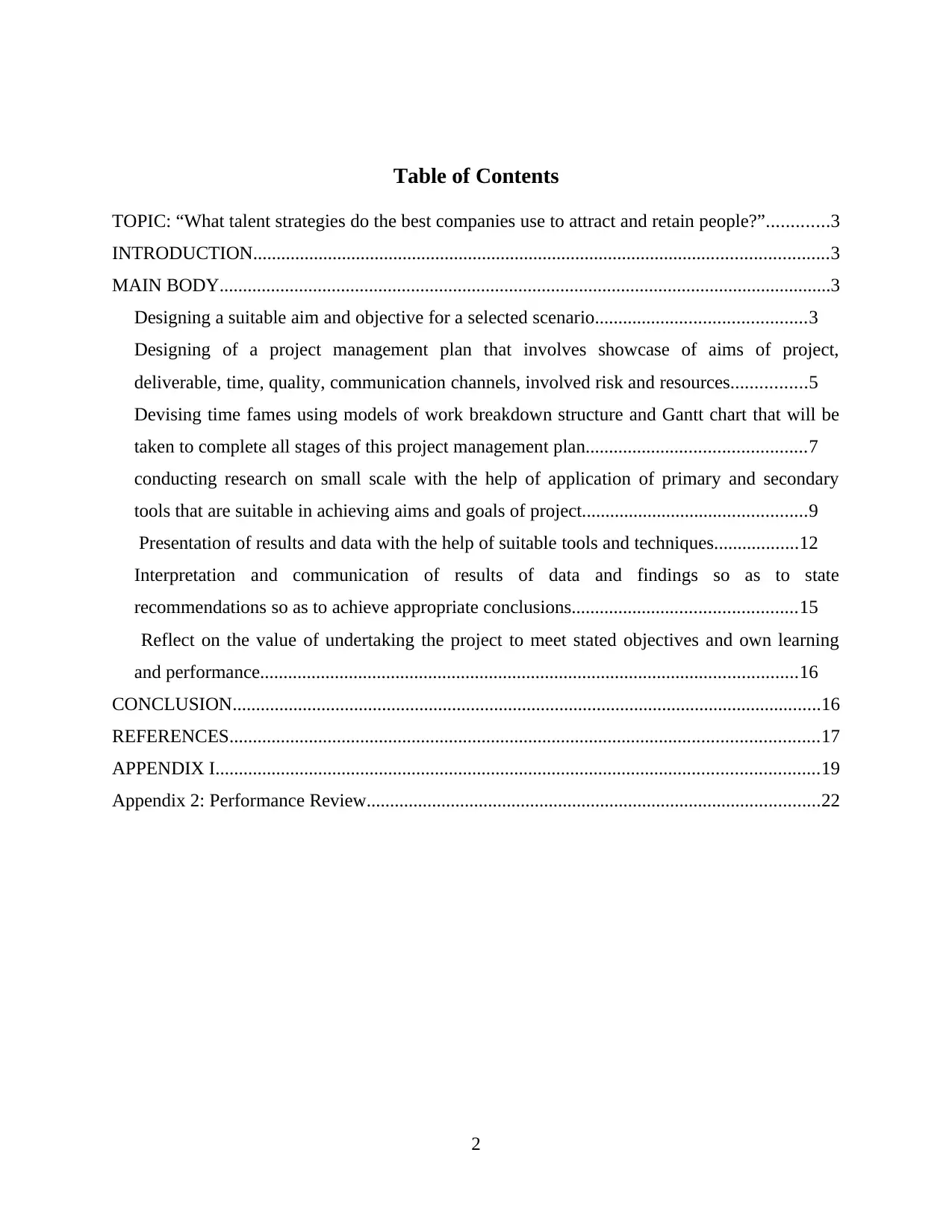
Table of Contents
TOPIC: “What talent strategies do the best companies use to attract and retain people?”.............3
INTRODUCTION...........................................................................................................................3
MAIN BODY...................................................................................................................................3
Designing a suitable aim and objective for a selected scenario.............................................3
Designing of a project management plan that involves showcase of aims of project,
deliverable, time, quality, communication channels, involved risk and resources................5
Devising time fames using models of work breakdown structure and Gantt chart that will be
taken to complete all stages of this project management plan...............................................7
conducting research on small scale with the help of application of primary and secondary
tools that are suitable in achieving aims and goals of project................................................9
Presentation of results and data with the help of suitable tools and techniques..................12
Interpretation and communication of results of data and findings so as to state
recommendations so as to achieve appropriate conclusions................................................15
Reflect on the value of undertaking the project to meet stated objectives and own learning
and performance...................................................................................................................16
CONCLUSION..............................................................................................................................16
REFERENCES..............................................................................................................................17
APPENDIX I.................................................................................................................................19
Appendix 2: Performance Review.................................................................................................22
2
TOPIC: “What talent strategies do the best companies use to attract and retain people?”.............3
INTRODUCTION...........................................................................................................................3
MAIN BODY...................................................................................................................................3
Designing a suitable aim and objective for a selected scenario.............................................3
Designing of a project management plan that involves showcase of aims of project,
deliverable, time, quality, communication channels, involved risk and resources................5
Devising time fames using models of work breakdown structure and Gantt chart that will be
taken to complete all stages of this project management plan...............................................7
conducting research on small scale with the help of application of primary and secondary
tools that are suitable in achieving aims and goals of project................................................9
Presentation of results and data with the help of suitable tools and techniques..................12
Interpretation and communication of results of data and findings so as to state
recommendations so as to achieve appropriate conclusions................................................15
Reflect on the value of undertaking the project to meet stated objectives and own learning
and performance...................................................................................................................16
CONCLUSION..............................................................................................................................16
REFERENCES..............................................................................................................................17
APPENDIX I.................................................................................................................................19
Appendix 2: Performance Review.................................................................................................22
2
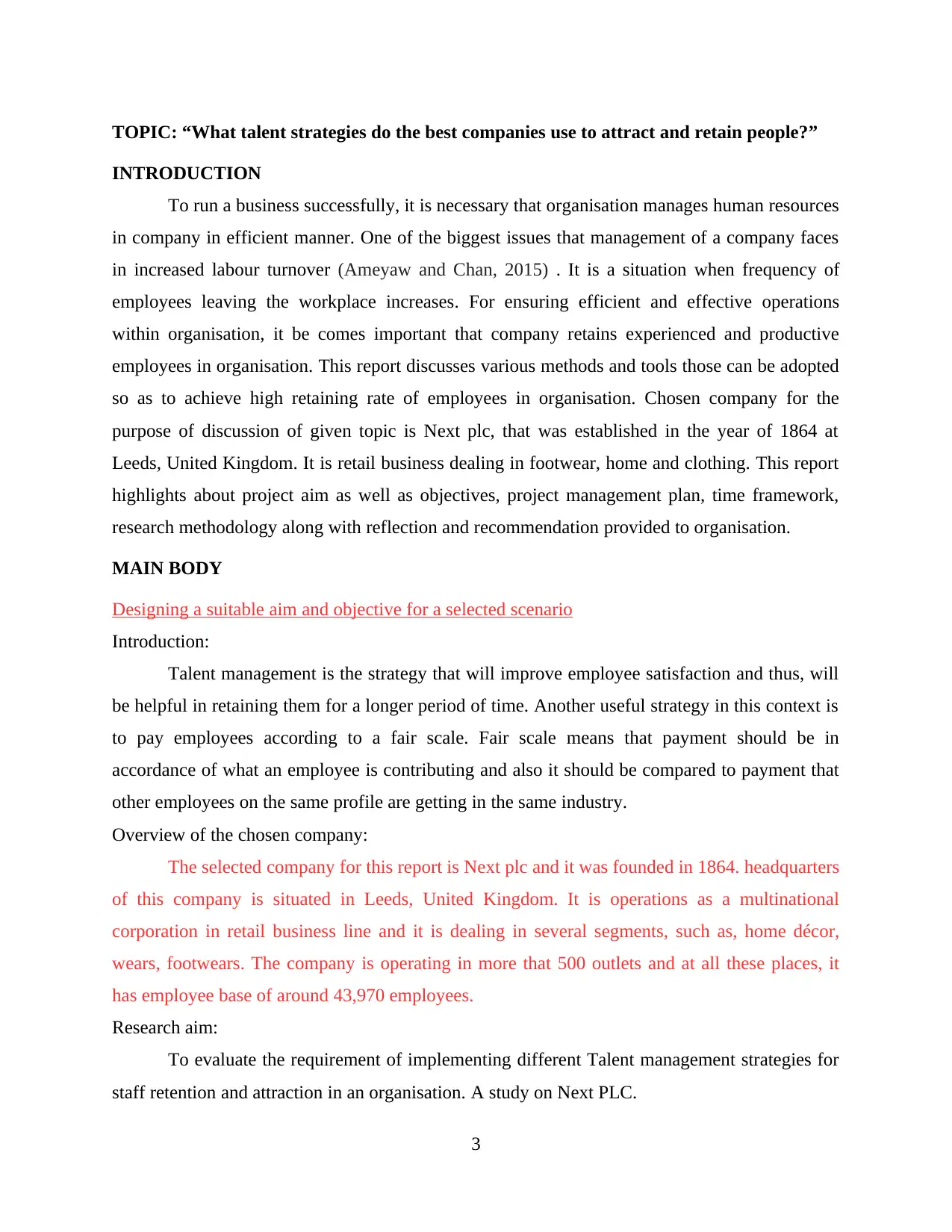
TOPIC: “What talent strategies do the best companies use to attract and retain people?”
INTRODUCTION
To run a business successfully, it is necessary that organisation manages human resources
in company in efficient manner. One of the biggest issues that management of a company faces
in increased labour turnover (Ameyaw and Chan, 2015) . It is a situation when frequency of
employees leaving the workplace increases. For ensuring efficient and effective operations
within organisation, it be comes important that company retains experienced and productive
employees in organisation. This report discusses various methods and tools those can be adopted
so as to achieve high retaining rate of employees in organisation. Chosen company for the
purpose of discussion of given topic is Next plc, that was established in the year of 1864 at
Leeds, United Kingdom. It is retail business dealing in footwear, home and clothing. This report
highlights about project aim as well as objectives, project management plan, time framework,
research methodology along with reflection and recommendation provided to organisation.
MAIN BODY
Designing a suitable aim and objective for a selected scenario
Introduction:
Talent management is the strategy that will improve employee satisfaction and thus, will
be helpful in retaining them for a longer period of time. Another useful strategy in this context is
to pay employees according to a fair scale. Fair scale means that payment should be in
accordance of what an employee is contributing and also it should be compared to payment that
other employees on the same profile are getting in the same industry.
Overview of the chosen company:
The selected company for this report is Next plc and it was founded in 1864. headquarters
of this company is situated in Leeds, United Kingdom. It is operations as a multinational
corporation in retail business line and it is dealing in several segments, such as, home décor,
wears, footwears. The company is operating in more that 500 outlets and at all these places, it
has employee base of around 43,970 employees.
Research aim:
To evaluate the requirement of implementing different Talent management strategies for
staff retention and attraction in an organisation. A study on Next PLC.
3
INTRODUCTION
To run a business successfully, it is necessary that organisation manages human resources
in company in efficient manner. One of the biggest issues that management of a company faces
in increased labour turnover (Ameyaw and Chan, 2015) . It is a situation when frequency of
employees leaving the workplace increases. For ensuring efficient and effective operations
within organisation, it be comes important that company retains experienced and productive
employees in organisation. This report discusses various methods and tools those can be adopted
so as to achieve high retaining rate of employees in organisation. Chosen company for the
purpose of discussion of given topic is Next plc, that was established in the year of 1864 at
Leeds, United Kingdom. It is retail business dealing in footwear, home and clothing. This report
highlights about project aim as well as objectives, project management plan, time framework,
research methodology along with reflection and recommendation provided to organisation.
MAIN BODY
Designing a suitable aim and objective for a selected scenario
Introduction:
Talent management is the strategy that will improve employee satisfaction and thus, will
be helpful in retaining them for a longer period of time. Another useful strategy in this context is
to pay employees according to a fair scale. Fair scale means that payment should be in
accordance of what an employee is contributing and also it should be compared to payment that
other employees on the same profile are getting in the same industry.
Overview of the chosen company:
The selected company for this report is Next plc and it was founded in 1864. headquarters
of this company is situated in Leeds, United Kingdom. It is operations as a multinational
corporation in retail business line and it is dealing in several segments, such as, home décor,
wears, footwears. The company is operating in more that 500 outlets and at all these places, it
has employee base of around 43,970 employees.
Research aim:
To evaluate the requirement of implementing different Talent management strategies for
staff retention and attraction in an organisation. A study on Next PLC.
3
⊘ This is a preview!⊘
Do you want full access?
Subscribe today to unlock all pages.

Trusted by 1+ million students worldwide
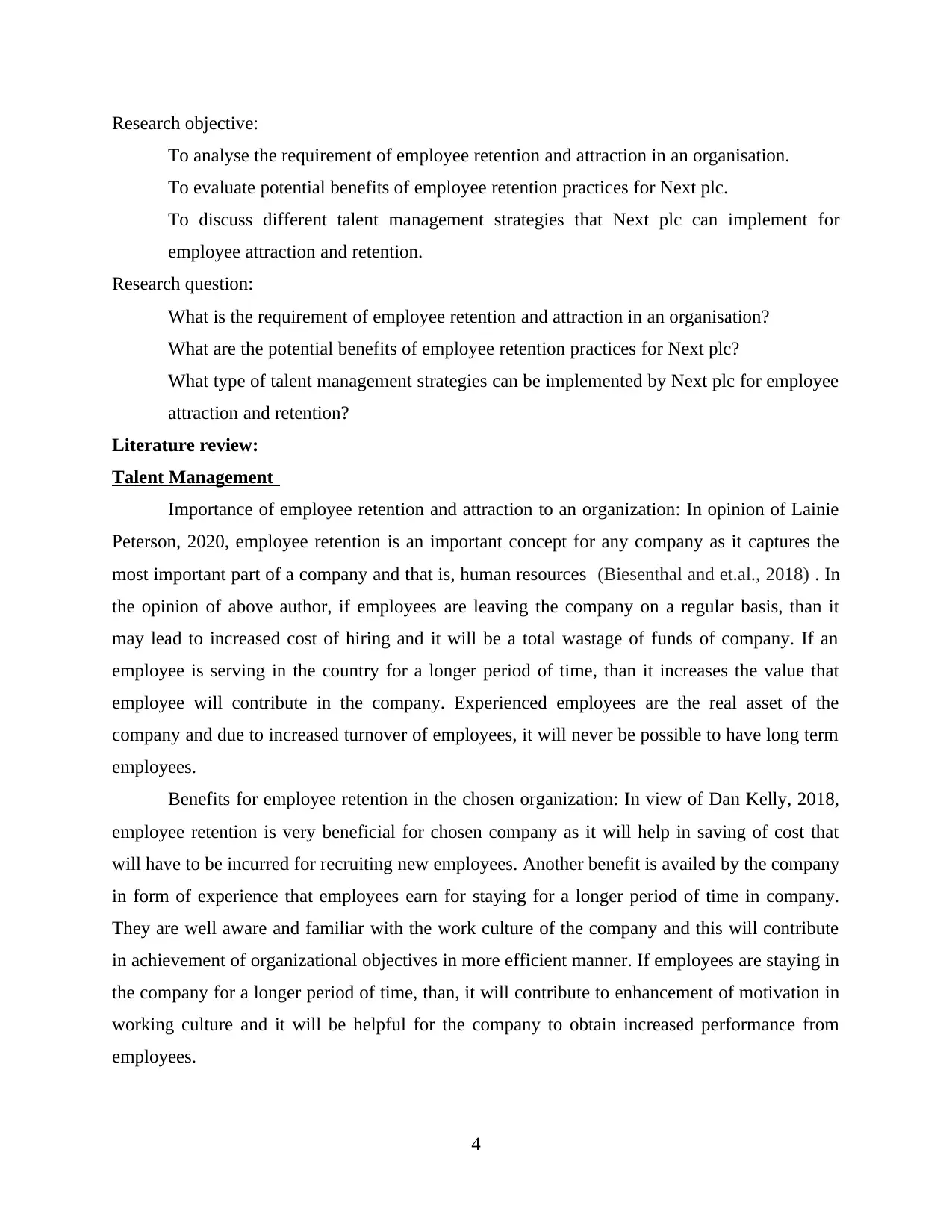
Research objective:
To analyse the requirement of employee retention and attraction in an organisation.
To evaluate potential benefits of employee retention practices for Next plc.
To discuss different talent management strategies that Next plc can implement for
employee attraction and retention.
Research question:
What is the requirement of employee retention and attraction in an organisation?
What are the potential benefits of employee retention practices for Next plc?
What type of talent management strategies can be implemented by Next plc for employee
attraction and retention?
Literature review:
Talent Management
Importance of employee retention and attraction to an organization: In opinion of Lainie
Peterson, 2020, employee retention is an important concept for any company as it captures the
most important part of a company and that is, human resources (Biesenthal and et.al., 2018) . In
the opinion of above author, if employees are leaving the company on a regular basis, than it
may lead to increased cost of hiring and it will be a total wastage of funds of company. If an
employee is serving in the country for a longer period of time, than it increases the value that
employee will contribute in the company. Experienced employees are the real asset of the
company and due to increased turnover of employees, it will never be possible to have long term
employees.
Benefits for employee retention in the chosen organization: In view of Dan Kelly, 2018,
employee retention is very beneficial for chosen company as it will help in saving of cost that
will have to be incurred for recruiting new employees. Another benefit is availed by the company
in form of experience that employees earn for staying for a longer period of time in company.
They are well aware and familiar with the work culture of the company and this will contribute
in achievement of organizational objectives in more efficient manner. If employees are staying in
the company for a longer period of time, than, it will contribute to enhancement of motivation in
working culture and it will be helpful for the company to obtain increased performance from
employees.
4
To analyse the requirement of employee retention and attraction in an organisation.
To evaluate potential benefits of employee retention practices for Next plc.
To discuss different talent management strategies that Next plc can implement for
employee attraction and retention.
Research question:
What is the requirement of employee retention and attraction in an organisation?
What are the potential benefits of employee retention practices for Next plc?
What type of talent management strategies can be implemented by Next plc for employee
attraction and retention?
Literature review:
Talent Management
Importance of employee retention and attraction to an organization: In opinion of Lainie
Peterson, 2020, employee retention is an important concept for any company as it captures the
most important part of a company and that is, human resources (Biesenthal and et.al., 2018) . In
the opinion of above author, if employees are leaving the company on a regular basis, than it
may lead to increased cost of hiring and it will be a total wastage of funds of company. If an
employee is serving in the country for a longer period of time, than it increases the value that
employee will contribute in the company. Experienced employees are the real asset of the
company and due to increased turnover of employees, it will never be possible to have long term
employees.
Benefits for employee retention in the chosen organization: In view of Dan Kelly, 2018,
employee retention is very beneficial for chosen company as it will help in saving of cost that
will have to be incurred for recruiting new employees. Another benefit is availed by the company
in form of experience that employees earn for staying for a longer period of time in company.
They are well aware and familiar with the work culture of the company and this will contribute
in achievement of organizational objectives in more efficient manner. If employees are staying in
the company for a longer period of time, than, it will contribute to enhancement of motivation in
working culture and it will be helpful for the company to obtain increased performance from
employees.
4
Paraphrase This Document
Need a fresh take? Get an instant paraphrase of this document with our AI Paraphraser
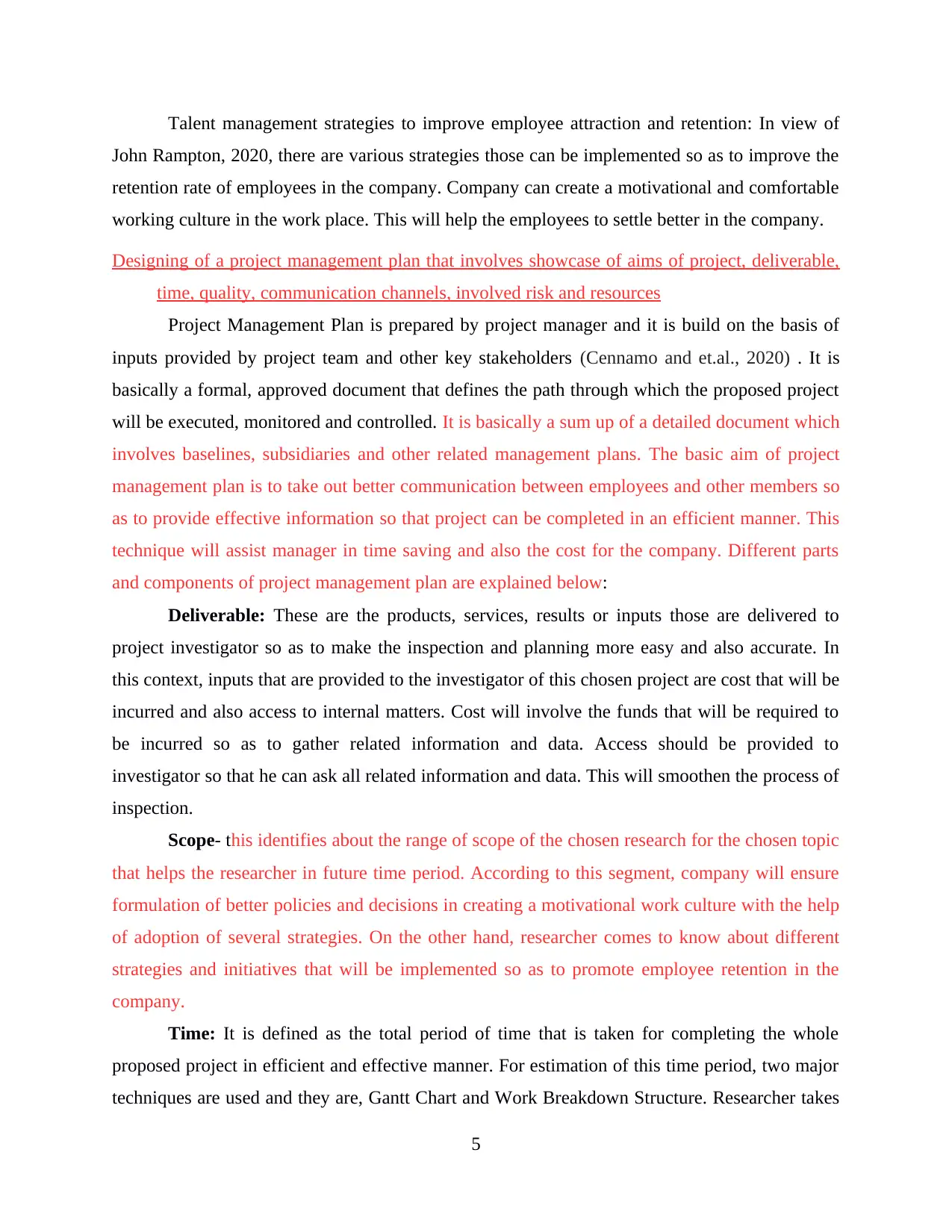
Talent management strategies to improve employee attraction and retention: In view of
John Rampton, 2020, there are various strategies those can be implemented so as to improve the
retention rate of employees in the company. Company can create a motivational and comfortable
working culture in the work place. This will help the employees to settle better in the company.
Designing of a project management plan that involves showcase of aims of project, deliverable,
time, quality, communication channels, involved risk and resources
Project Management Plan is prepared by project manager and it is build on the basis of
inputs provided by project team and other key stakeholders (Cennamo and et.al., 2020) . It is
basically a formal, approved document that defines the path through which the proposed project
will be executed, monitored and controlled. It is basically a sum up of a detailed document which
involves baselines, subsidiaries and other related management plans. The basic aim of project
management plan is to take out better communication between employees and other members so
as to provide effective information so that project can be completed in an efficient manner. This
technique will assist manager in time saving and also the cost for the company. Different parts
and components of project management plan are explained below:
Deliverable: These are the products, services, results or inputs those are delivered to
project investigator so as to make the inspection and planning more easy and also accurate. In
this context, inputs that are provided to the investigator of this chosen project are cost that will be
incurred and also access to internal matters. Cost will involve the funds that will be required to
be incurred so as to gather related information and data. Access should be provided to
investigator so that he can ask all related information and data. This will smoothen the process of
inspection.
Scope- this identifies about the range of scope of the chosen research for the chosen topic
that helps the researcher in future time period. According to this segment, company will ensure
formulation of better policies and decisions in creating a motivational work culture with the help
of adoption of several strategies. On the other hand, researcher comes to know about different
strategies and initiatives that will be implemented so as to promote employee retention in the
company.
Time: It is defined as the total period of time that is taken for completing the whole
proposed project in efficient and effective manner. For estimation of this time period, two major
techniques are used and they are, Gantt Chart and Work Breakdown Structure. Researcher takes
5
John Rampton, 2020, there are various strategies those can be implemented so as to improve the
retention rate of employees in the company. Company can create a motivational and comfortable
working culture in the work place. This will help the employees to settle better in the company.
Designing of a project management plan that involves showcase of aims of project, deliverable,
time, quality, communication channels, involved risk and resources
Project Management Plan is prepared by project manager and it is build on the basis of
inputs provided by project team and other key stakeholders (Cennamo and et.al., 2020) . It is
basically a formal, approved document that defines the path through which the proposed project
will be executed, monitored and controlled. It is basically a sum up of a detailed document which
involves baselines, subsidiaries and other related management plans. The basic aim of project
management plan is to take out better communication between employees and other members so
as to provide effective information so that project can be completed in an efficient manner. This
technique will assist manager in time saving and also the cost for the company. Different parts
and components of project management plan are explained below:
Deliverable: These are the products, services, results or inputs those are delivered to
project investigator so as to make the inspection and planning more easy and also accurate. In
this context, inputs that are provided to the investigator of this chosen project are cost that will be
incurred and also access to internal matters. Cost will involve the funds that will be required to
be incurred so as to gather related information and data. Access should be provided to
investigator so that he can ask all related information and data. This will smoothen the process of
inspection.
Scope- this identifies about the range of scope of the chosen research for the chosen topic
that helps the researcher in future time period. According to this segment, company will ensure
formulation of better policies and decisions in creating a motivational work culture with the help
of adoption of several strategies. On the other hand, researcher comes to know about different
strategies and initiatives that will be implemented so as to promote employee retention in the
company.
Time: It is defined as the total period of time that is taken for completing the whole
proposed project in efficient and effective manner. For estimation of this time period, two major
techniques are used and they are, Gantt Chart and Work Breakdown Structure. Researcher takes
5
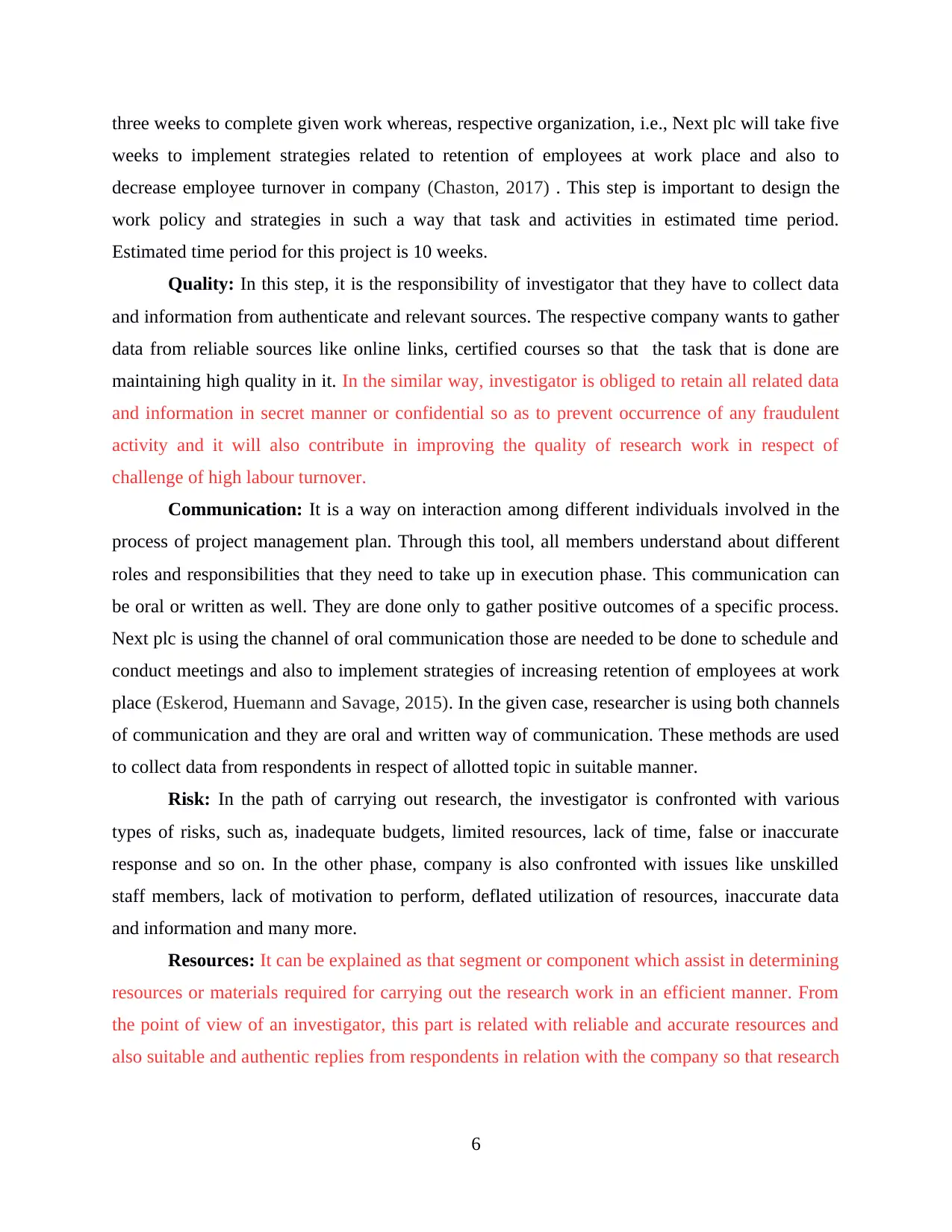
three weeks to complete given work whereas, respective organization, i.e., Next plc will take five
weeks to implement strategies related to retention of employees at work place and also to
decrease employee turnover in company (Chaston, 2017) . This step is important to design the
work policy and strategies in such a way that task and activities in estimated time period.
Estimated time period for this project is 10 weeks.
Quality: In this step, it is the responsibility of investigator that they have to collect data
and information from authenticate and relevant sources. The respective company wants to gather
data from reliable sources like online links, certified courses so that the task that is done are
maintaining high quality in it. In the similar way, investigator is obliged to retain all related data
and information in secret manner or confidential so as to prevent occurrence of any fraudulent
activity and it will also contribute in improving the quality of research work in respect of
challenge of high labour turnover.
Communication: It is a way on interaction among different individuals involved in the
process of project management plan. Through this tool, all members understand about different
roles and responsibilities that they need to take up in execution phase. This communication can
be oral or written as well. They are done only to gather positive outcomes of a specific process.
Next plc is using the channel of oral communication those are needed to be done to schedule and
conduct meetings and also to implement strategies of increasing retention of employees at work
place (Eskerod, Huemann and Savage, 2015). In the given case, researcher is using both channels
of communication and they are oral and written way of communication. These methods are used
to collect data from respondents in respect of allotted topic in suitable manner.
Risk: In the path of carrying out research, the investigator is confronted with various
types of risks, such as, inadequate budgets, limited resources, lack of time, false or inaccurate
response and so on. In the other phase, company is also confronted with issues like unskilled
staff members, lack of motivation to perform, deflated utilization of resources, inaccurate data
and information and many more.
Resources: It can be explained as that segment or component which assist in determining
resources or materials required for carrying out the research work in an efficient manner. From
the point of view of an investigator, this part is related with reliable and accurate resources and
also suitable and authentic replies from respondents in relation with the company so that research
6
weeks to implement strategies related to retention of employees at work place and also to
decrease employee turnover in company (Chaston, 2017) . This step is important to design the
work policy and strategies in such a way that task and activities in estimated time period.
Estimated time period for this project is 10 weeks.
Quality: In this step, it is the responsibility of investigator that they have to collect data
and information from authenticate and relevant sources. The respective company wants to gather
data from reliable sources like online links, certified courses so that the task that is done are
maintaining high quality in it. In the similar way, investigator is obliged to retain all related data
and information in secret manner or confidential so as to prevent occurrence of any fraudulent
activity and it will also contribute in improving the quality of research work in respect of
challenge of high labour turnover.
Communication: It is a way on interaction among different individuals involved in the
process of project management plan. Through this tool, all members understand about different
roles and responsibilities that they need to take up in execution phase. This communication can
be oral or written as well. They are done only to gather positive outcomes of a specific process.
Next plc is using the channel of oral communication those are needed to be done to schedule and
conduct meetings and also to implement strategies of increasing retention of employees at work
place (Eskerod, Huemann and Savage, 2015). In the given case, researcher is using both channels
of communication and they are oral and written way of communication. These methods are used
to collect data from respondents in respect of allotted topic in suitable manner.
Risk: In the path of carrying out research, the investigator is confronted with various
types of risks, such as, inadequate budgets, limited resources, lack of time, false or inaccurate
response and so on. In the other phase, company is also confronted with issues like unskilled
staff members, lack of motivation to perform, deflated utilization of resources, inaccurate data
and information and many more.
Resources: It can be explained as that segment or component which assist in determining
resources or materials required for carrying out the research work in an efficient manner. From
the point of view of an investigator, this part is related with reliable and accurate resources and
also suitable and authentic replies from respondents in relation with the company so that research
6
⊘ This is a preview!⊘
Do you want full access?
Subscribe today to unlock all pages.

Trusted by 1+ million students worldwide
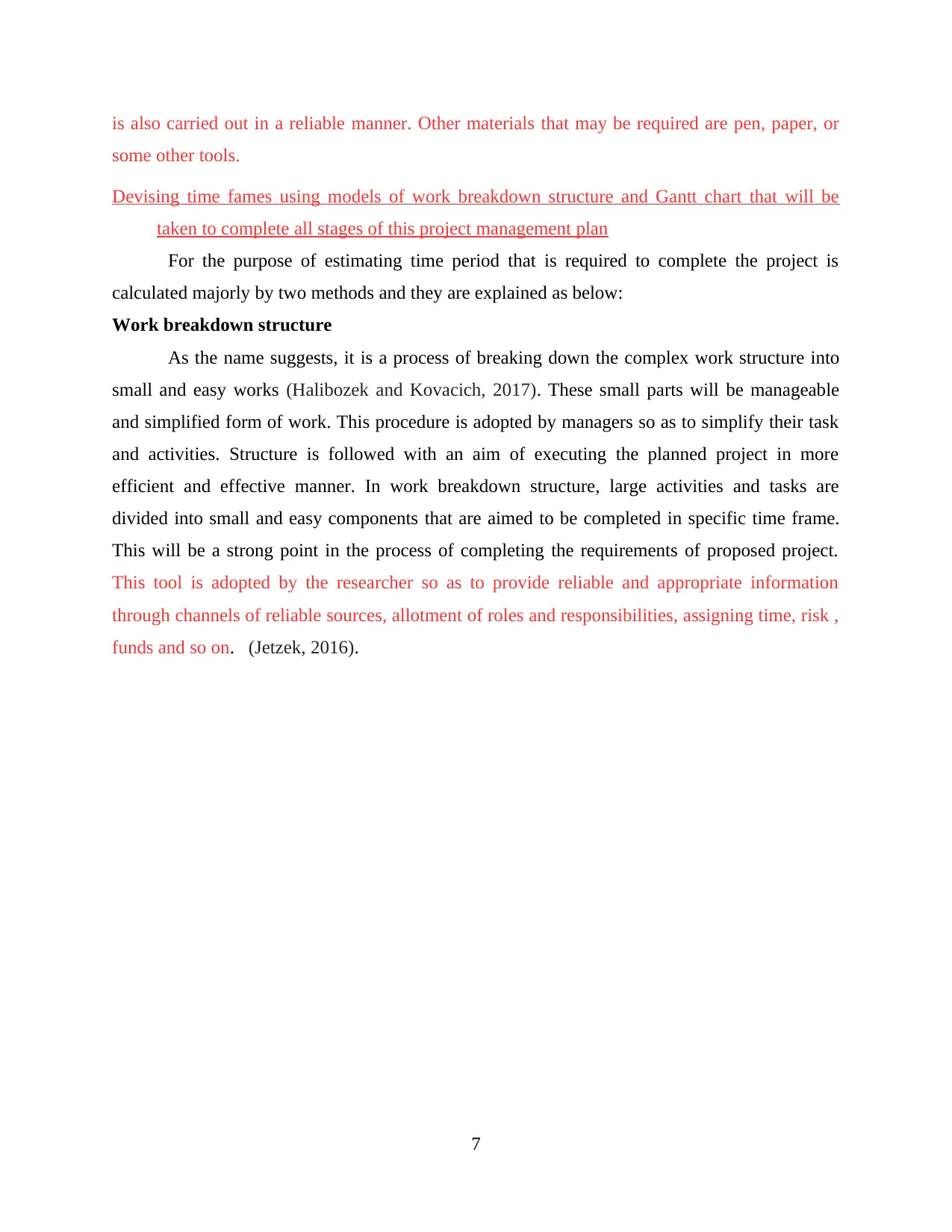
is also carried out in a reliable manner. Other materials that may be required are pen, paper, or
some other tools.
Devising time fames using models of work breakdown structure and Gantt chart that will be
taken to complete all stages of this project management plan
For the purpose of estimating time period that is required to complete the project is
calculated majorly by two methods and they are explained as below:
Work breakdown structure
As the name suggests, it is a process of breaking down the complex work structure into
small and easy works (Halibozek and Kovacich, 2017). These small parts will be manageable
and simplified form of work. This procedure is adopted by managers so as to simplify their task
and activities. Structure is followed with an aim of executing the planned project in more
efficient and effective manner. In work breakdown structure, large activities and tasks are
divided into small and easy components that are aimed to be completed in specific time frame.
This will be a strong point in the process of completing the requirements of proposed project.
This tool is adopted by the researcher so as to provide reliable and appropriate information
through channels of reliable sources, allotment of roles and responsibilities, assigning time, risk ,
funds and so on. (Jetzek, 2016).
7
some other tools.
Devising time fames using models of work breakdown structure and Gantt chart that will be
taken to complete all stages of this project management plan
For the purpose of estimating time period that is required to complete the project is
calculated majorly by two methods and they are explained as below:
Work breakdown structure
As the name suggests, it is a process of breaking down the complex work structure into
small and easy works (Halibozek and Kovacich, 2017). These small parts will be manageable
and simplified form of work. This procedure is adopted by managers so as to simplify their task
and activities. Structure is followed with an aim of executing the planned project in more
efficient and effective manner. In work breakdown structure, large activities and tasks are
divided into small and easy components that are aimed to be completed in specific time frame.
This will be a strong point in the process of completing the requirements of proposed project.
This tool is adopted by the researcher so as to provide reliable and appropriate information
through channels of reliable sources, allotment of roles and responsibilities, assigning time, risk ,
funds and so on. (Jetzek, 2016).
7
Paraphrase This Document
Need a fresh take? Get an instant paraphrase of this document with our AI Paraphraser
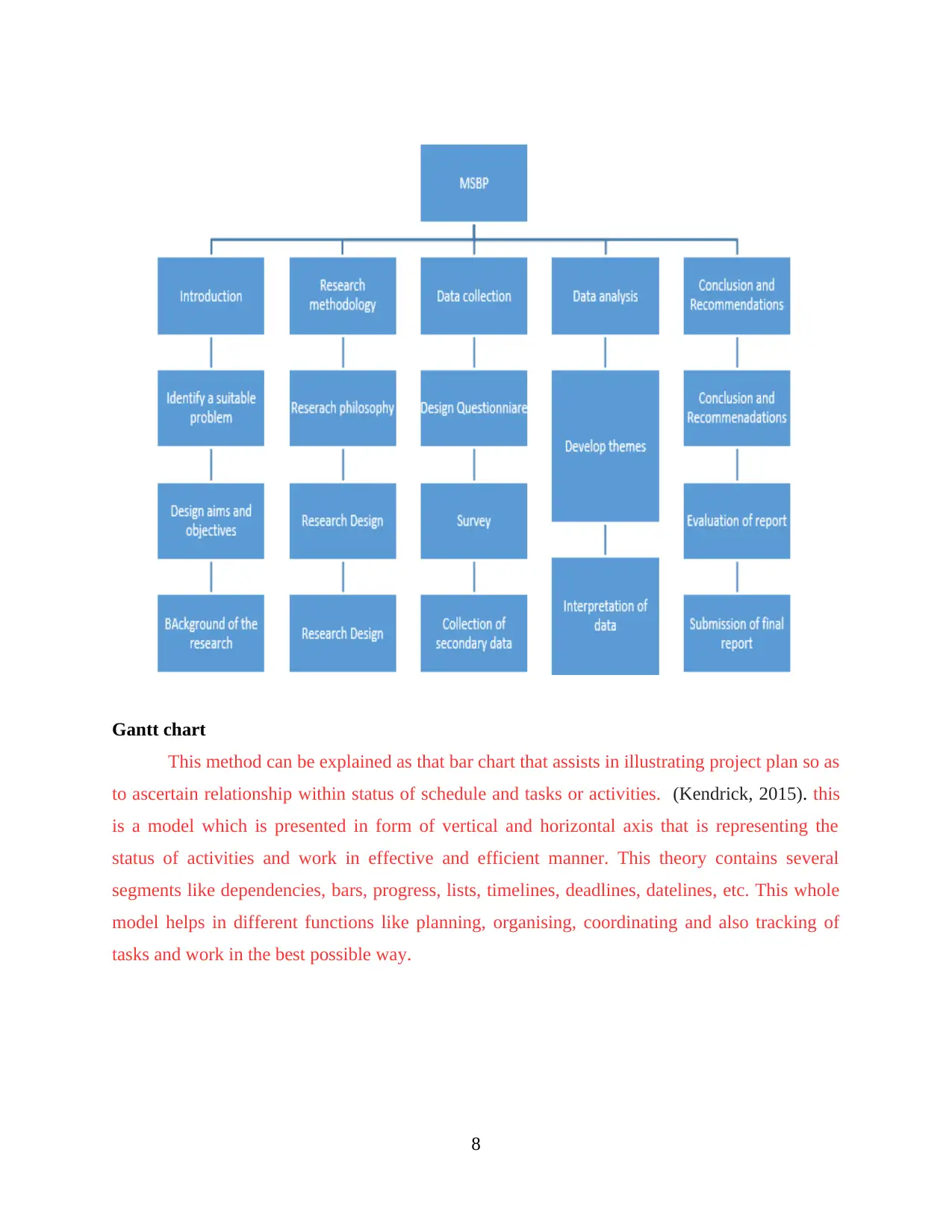
Gantt chart
This method can be explained as that bar chart that assists in illustrating project plan so as
to ascertain relationship within status of schedule and tasks or activities. (Kendrick, 2015). this
is a model which is presented in form of vertical and horizontal axis that is representing the
status of activities and work in effective and efficient manner. This theory contains several
segments like dependencies, bars, progress, lists, timelines, deadlines, datelines, etc. This whole
model helps in different functions like planning, organising, coordinating and also tracking of
tasks and work in the best possible way.
8
This method can be explained as that bar chart that assists in illustrating project plan so as
to ascertain relationship within status of schedule and tasks or activities. (Kendrick, 2015). this
is a model which is presented in form of vertical and horizontal axis that is representing the
status of activities and work in effective and efficient manner. This theory contains several
segments like dependencies, bars, progress, lists, timelines, deadlines, datelines, etc. This whole
model helps in different functions like planning, organising, coordinating and also tracking of
tasks and work in the best possible way.
8
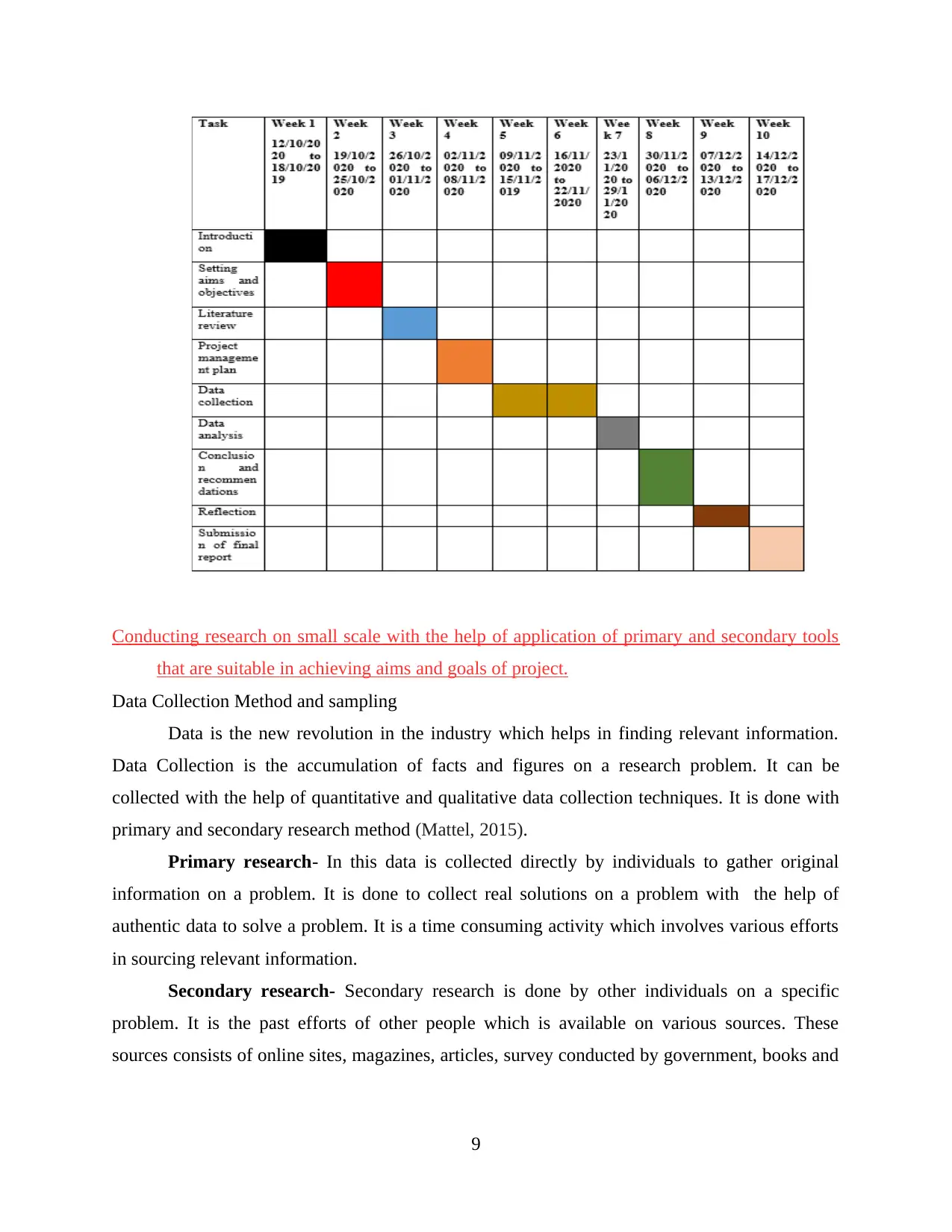
Conducting research on small scale with the help of application of primary and secondary tools
that are suitable in achieving aims and goals of project.
Data Collection Method and sampling
Data is the new revolution in the industry which helps in finding relevant information.
Data Collection is the accumulation of facts and figures on a research problem. It can be
collected with the help of quantitative and qualitative data collection techniques. It is done with
primary and secondary research method (Mattel, 2015).
Primary research- In this data is collected directly by individuals to gather original
information on a problem. It is done to collect real solutions on a problem with the help of
authentic data to solve a problem. It is a time consuming activity which involves various efforts
in sourcing relevant information.
Secondary research- Secondary research is done by other individuals on a specific
problem. It is the past efforts of other people which is available on various sources. These
sources consists of online sites, magazines, articles, survey conducted by government, books and
9
that are suitable in achieving aims and goals of project.
Data Collection Method and sampling
Data is the new revolution in the industry which helps in finding relevant information.
Data Collection is the accumulation of facts and figures on a research problem. It can be
collected with the help of quantitative and qualitative data collection techniques. It is done with
primary and secondary research method (Mattel, 2015).
Primary research- In this data is collected directly by individuals to gather original
information on a problem. It is done to collect real solutions on a problem with the help of
authentic data to solve a problem. It is a time consuming activity which involves various efforts
in sourcing relevant information.
Secondary research- Secondary research is done by other individuals on a specific
problem. It is the past efforts of other people which is available on various sources. These
sources consists of online sites, magazines, articles, survey conducted by government, books and
9
⊘ This is a preview!⊘
Do you want full access?
Subscribe today to unlock all pages.

Trusted by 1+ million students worldwide
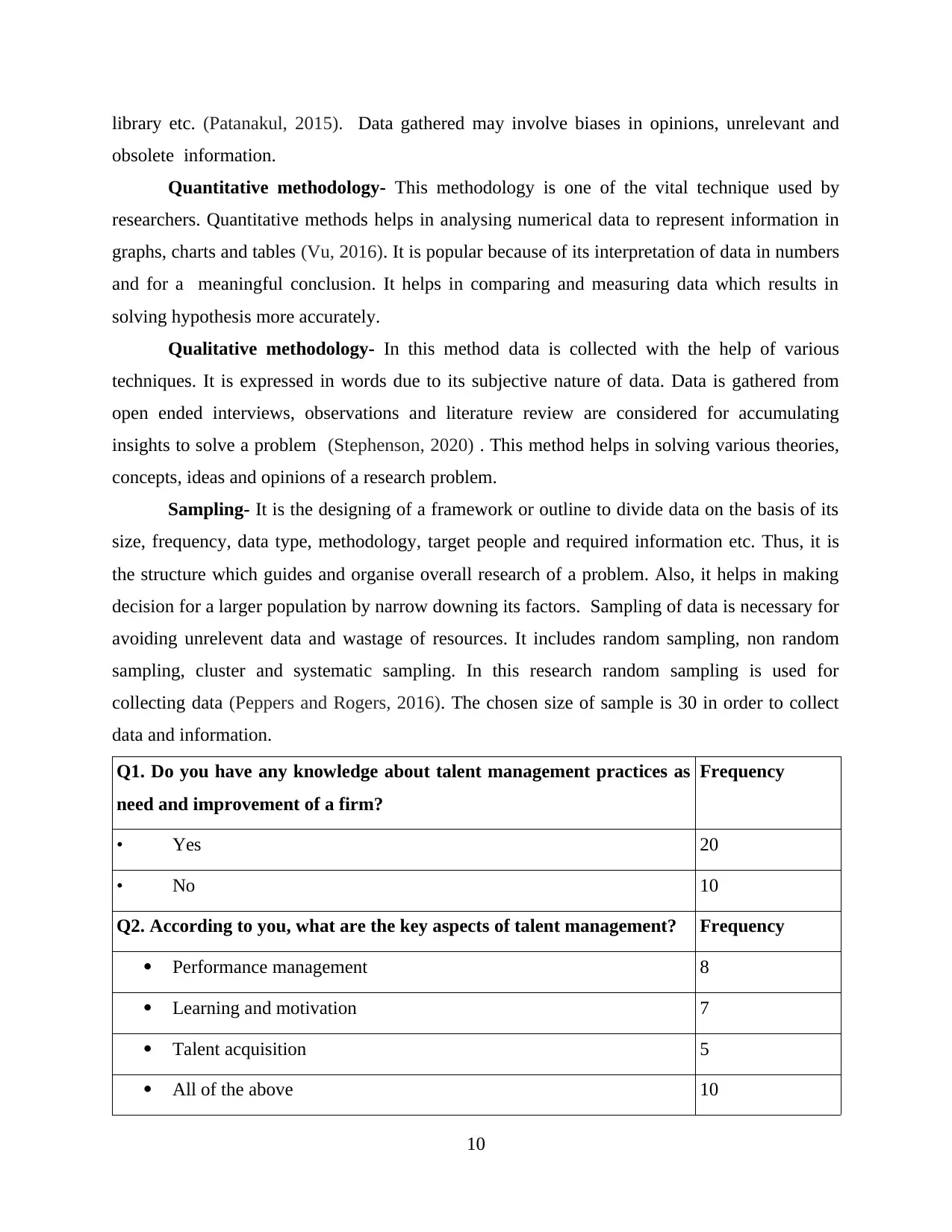
library etc. (Patanakul, 2015). Data gathered may involve biases in opinions, unrelevant and
obsolete information.
Quantitative methodology- This methodology is one of the vital technique used by
researchers. Quantitative methods helps in analysing numerical data to represent information in
graphs, charts and tables (Vu, 2016). It is popular because of its interpretation of data in numbers
and for a meaningful conclusion. It helps in comparing and measuring data which results in
solving hypothesis more accurately.
Qualitative methodology- In this method data is collected with the help of various
techniques. It is expressed in words due to its subjective nature of data. Data is gathered from
open ended interviews, observations and literature review are considered for accumulating
insights to solve a problem (Stephenson, 2020) . This method helps in solving various theories,
concepts, ideas and opinions of a research problem.
Sampling- It is the designing of a framework or outline to divide data on the basis of its
size, frequency, data type, methodology, target people and required information etc. Thus, it is
the structure which guides and organise overall research of a problem. Also, it helps in making
decision for a larger population by narrow downing its factors. Sampling of data is necessary for
avoiding unrelevent data and wastage of resources. It includes random sampling, non random
sampling, cluster and systematic sampling. In this research random sampling is used for
collecting data (Peppers and Rogers, 2016). The chosen size of sample is 30 in order to collect
data and information.
Q1. Do you have any knowledge about talent management practices as
need and improvement of a firm?
Frequency
• Yes 20
• No 10
Q2. According to you, what are the key aspects of talent management? Frequency
Performance management 8
Learning and motivation 7
Talent acquisition 5
All of the above 10
10
obsolete information.
Quantitative methodology- This methodology is one of the vital technique used by
researchers. Quantitative methods helps in analysing numerical data to represent information in
graphs, charts and tables (Vu, 2016). It is popular because of its interpretation of data in numbers
and for a meaningful conclusion. It helps in comparing and measuring data which results in
solving hypothesis more accurately.
Qualitative methodology- In this method data is collected with the help of various
techniques. It is expressed in words due to its subjective nature of data. Data is gathered from
open ended interviews, observations and literature review are considered for accumulating
insights to solve a problem (Stephenson, 2020) . This method helps in solving various theories,
concepts, ideas and opinions of a research problem.
Sampling- It is the designing of a framework or outline to divide data on the basis of its
size, frequency, data type, methodology, target people and required information etc. Thus, it is
the structure which guides and organise overall research of a problem. Also, it helps in making
decision for a larger population by narrow downing its factors. Sampling of data is necessary for
avoiding unrelevent data and wastage of resources. It includes random sampling, non random
sampling, cluster and systematic sampling. In this research random sampling is used for
collecting data (Peppers and Rogers, 2016). The chosen size of sample is 30 in order to collect
data and information.
Q1. Do you have any knowledge about talent management practices as
need and improvement of a firm?
Frequency
• Yes 20
• No 10
Q2. According to you, what are the key aspects of talent management? Frequency
Performance management 8
Learning and motivation 7
Talent acquisition 5
All of the above 10
10
Paraphrase This Document
Need a fresh take? Get an instant paraphrase of this document with our AI Paraphraser
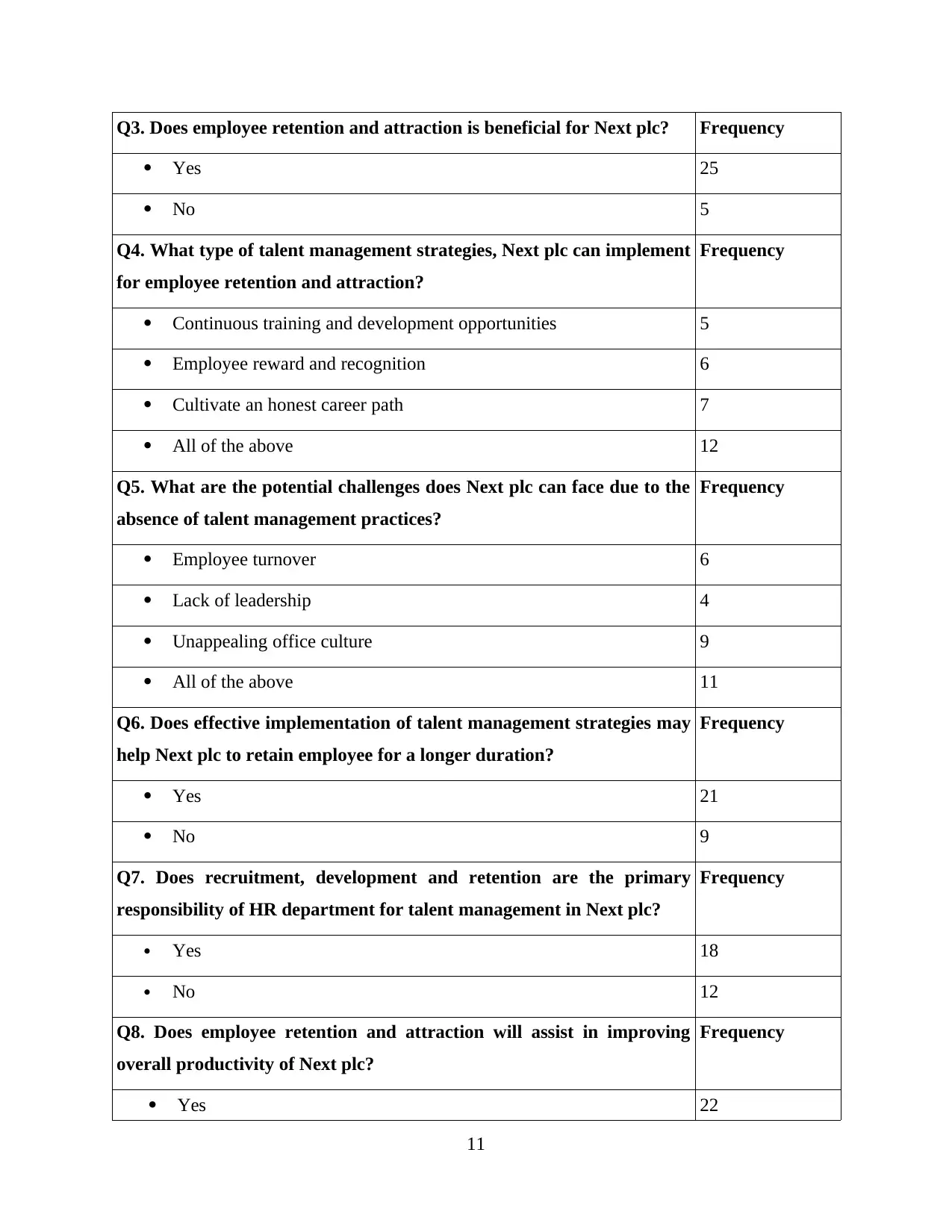
Q3. Does employee retention and attraction is beneficial for Next plc? Frequency
Yes 25
No 5
Q4. What type of talent management strategies, Next plc can implement
for employee retention and attraction?
Frequency
Continuous training and development opportunities 5
Employee reward and recognition 6
Cultivate an honest career path 7
All of the above 12
Q5. What are the potential challenges does Next plc can face due to the
absence of talent management practices?
Frequency
Employee turnover 6
Lack of leadership 4
Unappealing office culture 9
All of the above 11
Q6. Does effective implementation of talent management strategies may
help Next plc to retain employee for a longer duration?
Frequency
Yes 21
No 9
Q7. Does recruitment, development and retention are the primary
responsibility of HR department for talent management in Next plc?
Frequency
Yes 18
No 12
Q8. Does employee retention and attraction will assist in improving
overall productivity of Next plc?
Frequency
Yes 22
11
Yes 25
No 5
Q4. What type of talent management strategies, Next plc can implement
for employee retention and attraction?
Frequency
Continuous training and development opportunities 5
Employee reward and recognition 6
Cultivate an honest career path 7
All of the above 12
Q5. What are the potential challenges does Next plc can face due to the
absence of talent management practices?
Frequency
Employee turnover 6
Lack of leadership 4
Unappealing office culture 9
All of the above 11
Q6. Does effective implementation of talent management strategies may
help Next plc to retain employee for a longer duration?
Frequency
Yes 21
No 9
Q7. Does recruitment, development and retention are the primary
responsibility of HR department for talent management in Next plc?
Frequency
Yes 18
No 12
Q8. Does employee retention and attraction will assist in improving
overall productivity of Next plc?
Frequency
Yes 22
11
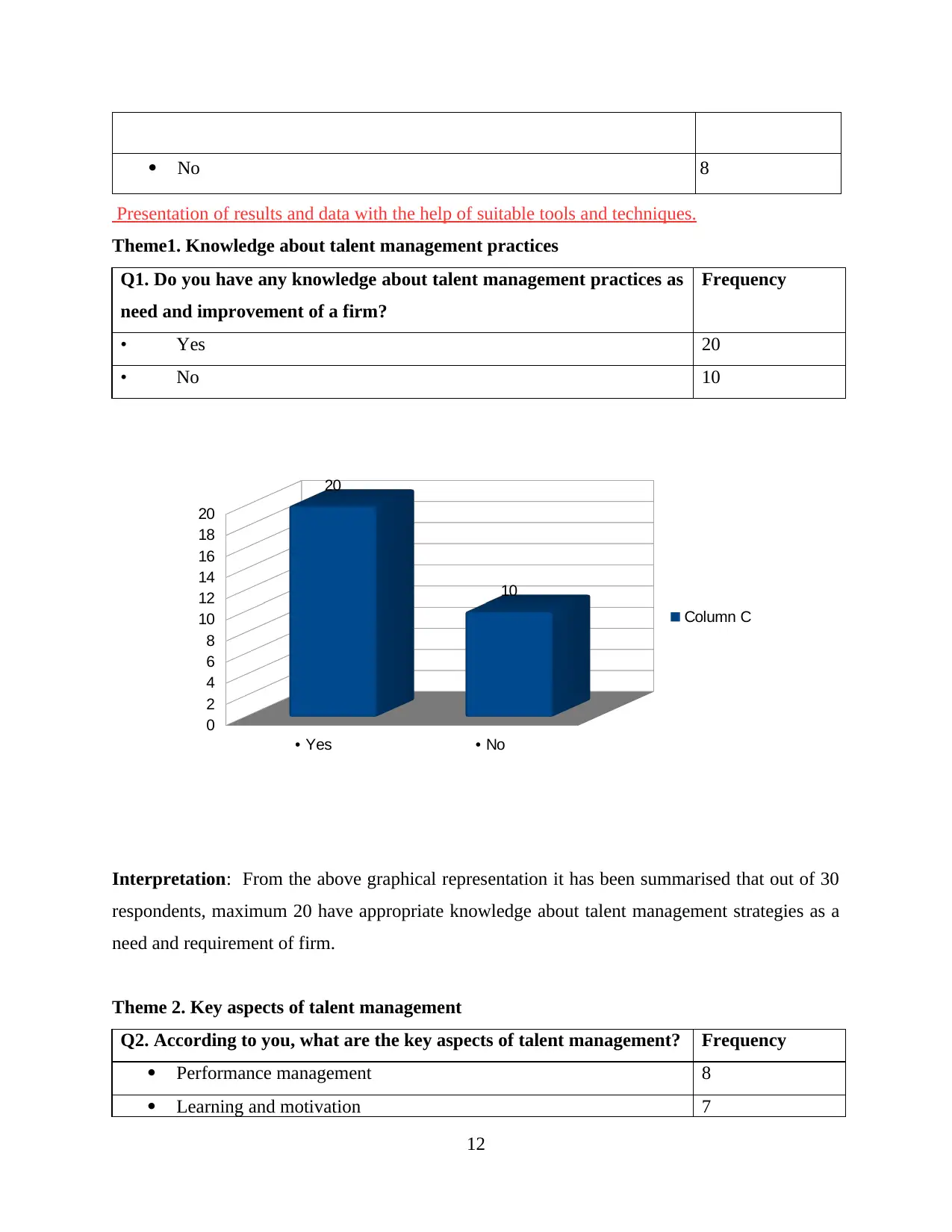
No 8
Presentation of results and data with the help of suitable tools and techniques.
Theme1. Knowledge about talent management practices
Q1. Do you have any knowledge about talent management practices as
need and improvement of a firm?
Frequency
• Yes 20
• No 10
Interpretation: From the above graphical representation it has been summarised that out of 30
respondents, maximum 20 have appropriate knowledge about talent management strategies as a
need and requirement of firm.
Theme 2. Key aspects of talent management
Q2. According to you, what are the key aspects of talent management? Frequency
Performance management 8
Learning and motivation 7
12
• Yes • No
0
2
4
6
8
10
12
14
16
18
20
20
10
Column C
Presentation of results and data with the help of suitable tools and techniques.
Theme1. Knowledge about talent management practices
Q1. Do you have any knowledge about talent management practices as
need and improvement of a firm?
Frequency
• Yes 20
• No 10
Interpretation: From the above graphical representation it has been summarised that out of 30
respondents, maximum 20 have appropriate knowledge about talent management strategies as a
need and requirement of firm.
Theme 2. Key aspects of talent management
Q2. According to you, what are the key aspects of talent management? Frequency
Performance management 8
Learning and motivation 7
12
• Yes • No
0
2
4
6
8
10
12
14
16
18
20
20
10
Column C
⊘ This is a preview!⊘
Do you want full access?
Subscribe today to unlock all pages.

Trusted by 1+ million students worldwide
1 out of 28
Related Documents
Your All-in-One AI-Powered Toolkit for Academic Success.
+13062052269
info@desklib.com
Available 24*7 on WhatsApp / Email
![[object Object]](/_next/static/media/star-bottom.7253800d.svg)
Unlock your academic potential
Copyright © 2020–2025 A2Z Services. All Rights Reserved. Developed and managed by ZUCOL.




